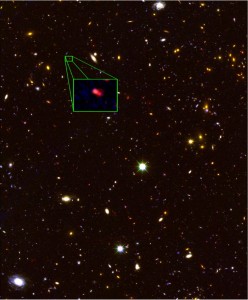Astronomers Analyze Most Distant Galaxy Yet
Astronomers are reaching ever closer to the edge of the universe, as a team led by a Texas scientist has identified the most distant galaxy found yet.
Using measurements from the W.M. Keck Observatory on Mauna Kea, astronomer Steven Finkelstein of the University of Texas at Austin has determined the galaxy is being seen as it appeared just 700 million years after the Big Bang, when the universe was only about 5% of its current age.
That means it is being observed as it looked more than 13 billion years ago.
Galaxy z8_GND_5296 was among numerous celestial bodies first found by the Hubble Space Telescope’s CANDELS program.
Finkelsein and others then carried out further studies using the 10-meter Keck I telescope fitted with the MOSFIRE, a state-of-the-art instrument that can detect and measure faint light for its various properties.
Those properties tell astronomers how far away objects are are based on changes in the wavelengths of light, which moves at a constant speed of about 186,000 miles per second.
In the case of the most distant galaxies, scientists measure how their collective blue light gets shifted toward redder colors as they move further from Earth through the expansion of the universe. This “redshift” is analogous to the way a siren changes in sound as it moves further away in what is known as the Doppler effect.

This image from the Hubble Space Telescope CANDELS survey highlights the most distant galaxy in the universe with a measured distance. The galaxy’s red color alerted astronomers that it was likely extremely far away, and thus seen at a time not long after the Big Bang. Photo by V. Tilvi, S.L. Finkelstein, C. Papovich, A. Koekemoer, CANDELS, and STScI/NASA.
Because of its great distance, the astronomers observed that this galaxy has the highest redshift ever confirmed, Keck said in a statement issued today.
“We want to study very distant galaxies to learn how they change with time,” Finkelstein said in the statement. “This helps us understand how the Milky Way came to be.”
The team’s observations also showed that the galaxy is forming stars at an extremely rapid rate — 150 times faster than our own Milky Way galaxy. It is also located in the same part of the sky as the previous redshift record-holder, which also has a very high rate of star formation.
“So we’re learning something about the distant universe,” Finkelstein said, adding that finding two regions with very high star-formation rates in the same part of the sky suggests there are likely more than previously thought.
The astronomers used another NASA space telescope, the Spitzer, to measure how much ionized oxygen the galaxy contains, which helps determine the rate of star formation.











